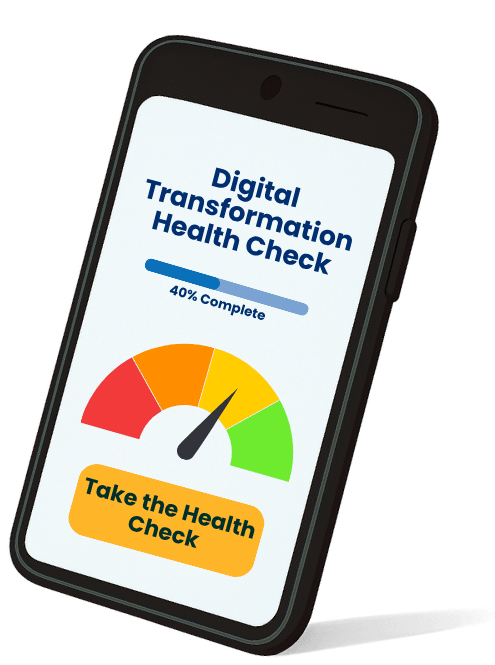In today’s fast-paced digital world, agility isn’t just a buzzword‚ it’s a survival skill. You’re either quick on your feet, ready to pivot at a moment’s notice, or you’re left in the dust. This is particularly true when it comes to Digital Transformation.
Why is agility so crucial, you ask? Well, imagine trying to navigate a rapidly changing digital landscape with the speed of a tortoise. It’s not going to end well, is it? That’s why we’re exploring the concept of Digital Transformation agility, shedding light on its importance, and how you can harness it to future-proof your business.
Understanding Digital Transformation Agility
Grasping the notion of Digital Transformation Agility involves comprehending the intertwining cords of technology and business strategy. It’s about recognising the role that speed, efficiency, and adaptability play in facing the challenges of the cyberspace.
Firstly, Digital Transformation Agility relates to applying digital technologies proficiently. Not just assimilation of new tech, but comprehensive understanding and implementation across all organisational levels. For instance, a retail store incorporates AI-based chatbots on their website for improved customer communication.
Secondly, it’s a strategic business move. Rather than treating tech adoption as an isolated operation, businesses integrate it into their organisational strategies. An example is a manufacturing firm using data analytics for predictive maintenance, thereby increasing operational efficiency.
Next, versatility in responding to change comes to the picture. The digital landscape shifts constantly. Digital Transformation Agility implies rapidly altering digital strategies to embrace these changes, like a payment platform evolving its security measures in response to new cybercrime methods.
Finally, agility in this sphere implies collaboration, both internal and external. There’s shared responsibility and flexible resource allocation. Teams are assembled quickly, tasks reassigned, resources recalibrated – it’s about swift, informed decisions. An example could be a software development company shifting coders between projects based on expertise and project requirements.
Understanding Digital Transformation Agility is not just about acknowledging these aspects, but actively incorporating them within your business. In doing so, you’re crafting a resilient, agile organisation, ready to withstand the tumultuous waves of the digital sea.
Exploring the Pillars of Digital Transformation Agility
In striving to master digital transformation agility, three key pillars stand front and centre. These are technology incorporation, nimble adaptation, and effective collaboration.
Embracing technologies forms the first pillar. It’s here that an optimal blend of digitisation, automation, and analytics come into play. For instance, an enterprise resource planning (ERP) system enhances automation, while analytics derived from customer data insights can fuel digitisation drives. They present businesses, such as UK-based SMEs, with the potential to streamline operations, boost productivity, and even uncover potential innovation opportunities.
Next, nimble adaptation to the digital landscape emerges as the second pillar. Market dynamics and customer behaviours continually shift in response to emerging technologies and unforeseen circumstances. Cloud computing, for example, has revolutionised database management, altered consumer expectations, and completely changed the game for businesses so adapting to these changes is crucial to maintain your competitive edge.
The final pillar is effective collaboration. This can take many forms, from inter-departmental synergies to partnerships with external technology vendors. The core idea is to foster a culture that supports shared responsibility and flexible resourcing. This aids in accelerating digital projects, presenting a win in the rapidly evolving digital sphere.
However, despite these pillars providing a solid base, achieving digital transformation agility extends far beyond implementing them in isolation. True digital agility demands an ongoing strategic approach, assimilating these pillars into everyday operations and continuously revising them in line with emerging trends. Remember, the digital landscape churns out new opportunities and threats daily, so your digital strategy must evolve in parallel to remain competitive.
By concentrating on these pillars, you – as a business leader – can establish a foundation for digital transformation agility. Consequently, digital agile methodology is no longer an abstract concept, but an achievable goal within your grasp. It’s about time to turn that digital ability into digital agility. Remember the saying: “The future belongs to the agile”.
Critical Role of Digital Transformation Agility in Businesses
Digital Transformation Agility plays a pivotal role in business operations. It serves as a linchpin in the interplay of strategy, technology, and adaptability. It isn’t about incorporating technology for technology’s sake. Instead, it’s about leveraging digital tools to drive your business growth and gain a competitive edge.
Let’s delve into the three-fold role of Digital Transformation Agility:
- Technology Incorporation: A winning strategy requires the adept application of available digital tools. Using technologies like Enterprise Resource Planning (ERP) systems and data analytics, businesses can streamline operations, reduce downtime, and enhance decision making. For example, utilising big data analytics empowers better customer insight and targeted marketing efforts.
- Nimble Adaptation: Market dynamics change in the blink of an eye. Being agile aids your business in swiftly responding to these changes, tapping into opportunities and mitigating risks. For instance, with the shift to remote work, businesses can pivot to cloud computing to ensure business continuity, efficiency, and data security.
- Effective Collaboration: Digital Transformation Agility fosters an environment where team collaboration thrives. It provides tools that make teamwork more efficient and impactful. For instance, using collaboration platforms improves communication and project execution, leading to better outcomes.
Ultimately, Digital Transformation Agility isn’t a one-time project, it’s an ongoing journey of continuous learning, adapting, and innovating. By integrating these three pillars into your business operations, you’re setting up a strong foundation for enduring success in the digital marketplace.
Navigating the digital landscape might seem daunting, but with strategic vision and digital agility, you can turn the tide in your favour. Remember, in today’s digital-driven economy, agility isn’t just a competitive advantage, it’s your ultimate survival kit.
Case Studies of Successful Digital Transformation Agility
Reflecting on real-world examples, here, we dive into a couple of notable case studies that highlight successful digital transformation agility.
Dominos, once just your average pizza delivery company, embraced digital transformation and displayed impressive agility. Instead of settling for their traditional methods, they moved their focus from in-store services to a digital-first approach. Dominos underwent a major technological transformation, implementing AI and analytics systems to improve their customer experience. For instance, they introduced an AI-powered Chatbot, ‘Dom’, providing users with a seamless, efficient, and amusing ordering process. This innovative move made them a leader in the digital arena, surpassing competitors like pizza hut in digital sales. From these meticulous strategies arose a high-tech pizza delivery stronghold, demonstrating strong digital transformation agility.
Next is General Electric (GE), a renowned industrial company that presented exceptional agility via their digital transformation journey. In the race of the competitive industrial market, GE didn’t hold back from embracing change. They responded to the increasing digital demands promptly, capitalising on powerful digital tools like IoT, analytics, and machine learning. A prime example of their agility lies in GE’s creation of Predix, a cloud-based Platform-as-a-Service targeting the industries in the realm of IoT. GE’s evolution from a traditional to a digital industrial leader shows their commitment to embracing digital transformation agility.
From these examples, you see just how crucial digital transformation agility pushes enterprises forward. Without fearing disruption and maintaining nimble adaption, businesses such as Dominos and GE have adopted a digital-focused approach, underlining the benefits of enabling digital agile practices.
Implementing Digital Transformation Agility
Building on the fundamentals of Digital Transformation Agility, it’s time to venture into its execution phase. Implementing digital agility necessitates the symbiotic correlation of technology adoption, agile adaptation, and focused collaboration. But remember, digital agility isn’t a one-size-fits-all solution; it demands a deliberate, flexible strategy custom-fitted to your business landscape.
Let’s explore the pillars for implementing digital transformation agility successfully:
- Optimised Technology Integration: Choose technologies that align with your business objectives. From leveraging ERP systems to harnessing data analytics, ensure these tools act as catalysts for your digital growth. Netflix provides a spectacular example of this. Known for its digital agility, the firm effectively deploys data analytics, resulting in personalised recommendations that resonate with 80% of viewers.
- Nimble Adaptation: Adjust and shift according to the digital pivot. Staying ahead means embracing changes in technology and market dynamics. Cloud computing, for example, is a frontier almost every business is exploring. Spotify’s move to Google Cloud Platform emphasises how cloud adoption can fuel agility and innovation in a business.
- Effective Collaboration: Foster internal collaboration and cultivate robust partnerships with external stakeholders. Pioneers in digital agility, such as Amazon, demonstrate the power of collaborative innovation. Its partnership with the USPS (United States Postal Service) for Sunday deliveries shows how effective collaborations result in significant business growth and enhanced customer experience.
Implementing digital transformation agility is indeed a comprehensive process, but with thoughtful selection of technology, agility in adapting to change, and strategic collaboration, your business stands to gain significantly. As you journey into the digital sphere, remember – agility is not a sprint; it is indeed a marathon. Today’s digital landscape demands businesses to emulate the likes of Dominos and GE, constantly evolving, ever resilient, and persistently pushing the boundaries of digital proficiency. So, gear up and step assuredly into the realm of digital agility.
Conclusion
You’ve journeyed through the realm of Digital Transformation Agility, understanding its crucial role in bridging technology and business strategy. You’ve seen how adaptability, collaboration, and strategic tech adoption are not just buzzwords, but essential elements for success. You’ve explored the pillars of agility – technology incorporation, nimble adaptation, and effective collaboration – and witnessed their power in action with Dominos and GE.
You’ve also gleaned insights into tailoring your strategies for technology integration, agile adaptation, and collaboration, inspired by the likes of Netflix, Spotify, and Amazon. Now, as you step back into your business world, remember that agility in the digital landscape isn’t a one-time goal. It’s an ongoing journey, a constant evolution. So, keep pushing your boundaries, keep evolving, and you’ll be on your way to mastering Digital Transformation Agility.



